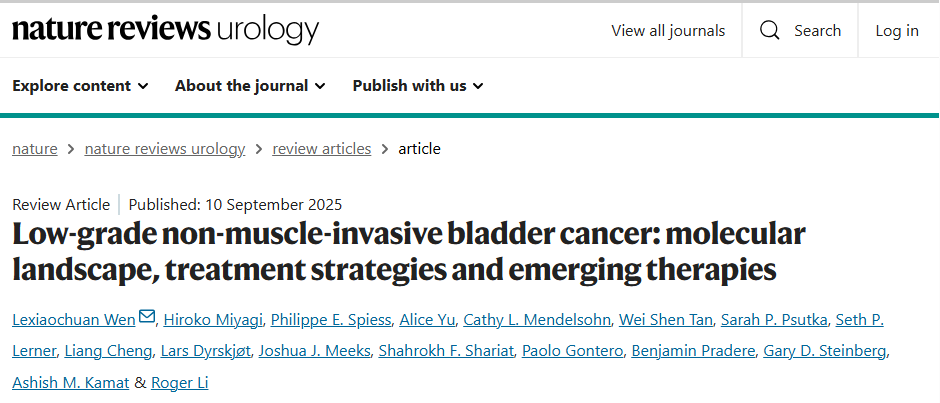Liang Cheng, Director of Anatomic Pathology and Director of Molecular Pathology at Lifespan Academic Medical Center and Vice Chair for Translational Research at the Warren Alpert Medical School of Brown University, shared a post on LinkedIn about a recent article he and his colleagues co-authored, adding:
” ‘Low-grade Non–Muscle-Invasive Bladder Cancer: Molecular Landscape, Treatment Strategies, and Emerging Therapies’ – just published in Nature Reviews Urology. This State-of-the-Art review by Roger Li , Lexi Wen, and colleagues offers an outstanding overview of advances in molecular biology, diagnosis, targeted therapies, and clinical management for bladder cancer. A great honor to be part of this effort.
Summary:
The management of low-grade non–muscle-invasive bladder cancer (NMIBC) is undergoing rapid evolution, driven by a growing recognition of the need for nuanced, risk-adapted strategies that minimize overtreatment. Yet widespread adoption of de-escalated approaches remains limited by the lack of well-defined, evidence-based guidelines tailored to this favorable-prognosis disease subset. Clear recommendations – particularly regarding surveillance frequency, duration, and criteria for de-intensified care – will likely require international consensus efforts supported by robust prospective data.
A major priority for future research is refining risk stratification. Distinguishing patients at truly increased risk of progression from those with indolent disease will enable more personalized management, including appropriate use of active surveillance and reduced surveillance intensity. Advances in molecular profiling, urine-based biomarkers, and AI-assisted pathology show promise for identifying meaningful biomarkers and histologic patterns to support such stratification, but rigorous prospective validation remains essential before broad clinical adoption.
AI integration into clinical workflows offers additional opportunities to enhance diagnostic accuracy, predict recurrence or progression, and support individualized decision-making. Multimodal models capable of real-time risk assessment may eventually guide therapy selection, but challenges – including the need for diverse training datasets, transparent algorithms, and clear ethical and regulatory frameworks – must be addressed before routine clinical use.
Patients with multiple risk factors generally warrant intravesical therapy, while those without risk factors may be reasonable candidates for active surveillance. The ongoing BCG shortage further underscores the need to balance clinical benefit with treatment burden and to evaluate new intravesical therapies against their potential financial and clinical toxicity.
Meaningful progress in low-grade NMIBC will depend on prospective validation of emerging technologies and therapies, paired with thoughtful integration into evidence-based guidelines. By aligning molecular insights, technological innovation, and risk-adapted clinical practice, the field can improve outcomes while reducing unnecessary interventions and surveillance for this common, yet often overtreated, disease.”
Title: Low-grade non-muscle-invasive bladder cancer: molecular landscape, treatment strategies and emerging therapies
Authors: Lexiaochuan Wen, Hiroko Miyagi, Philippe E. Spiess, Alice Yu, Cathy L. Mendelsohn, Wei Shen Tan, Sarah P. Psutka, Seth P. Lerner, Liang Cheng, Lars Dyrskjøt, Joshua J. Meeks, Shahrokh F. Shariat, Paolo Gontero, Benjamin Pradere, Gary D. Steinberg, Ashish M. Kamat, Roger Li
Read the Full Article on Nature Reviews Urology.

More posts featuring Liang Cheng.
